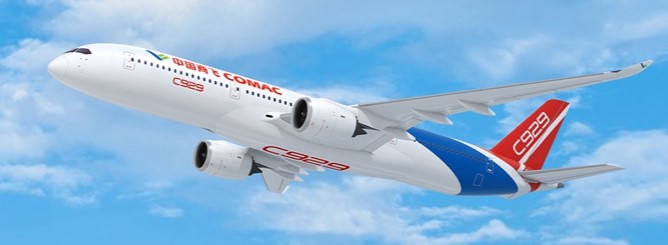Airlines
Russia Persists in Long-Range Aircraft Collaboration with China Amid Sanctions

Amidst geopolitical challenges, Russia remains steadfast in its commitment to collaborate with china on the long-range aircraft project, emphasizing a continued focus on research and development of key components. The partnership, although facing setbacks due to sanctions leading to Russia’s withdrawal from the CR929 program, is exploring alternative avenues for cooperation.
As part of the altered situation, Russia’s Minister of Industry and Trade, Denis Manturov, declared that his country would continue to work with China on the long-range aircraft project. He clarified that although the project’s cooperation is changing, advancement is still a priority, especially when it comes to the development of important components.
In September, Comac announced that it had established a lab to create what it was now referring to as the C929, instead of the CR929; many analysts took this to mean that Russia would not be involved in any further development.
When the decision was made to leave the CR929 programme, concerns were first raised about the future of collaborative efforts and the possibility that sanctions would have a chain reaction on the project as a whole. But Manturov’s remark suggests a change in direction, emphasizing contractual agreements for particular aircraft parts, showing a practical way to maintain cooperation.
Manturov highlighted that russia, while navigating challenges, is directing efforts toward developing crucial components for domestically produced aircraft like the short-range SSJ-100 and the medium-range MC-21 passenger plane. This strategic emphasis on import substitution aims to ensure self-reliance in key aviation technologies.
As Russia and China adapt to changing circumstances, their commitment to collaborative ventures remains resilient, reflecting a shared vision for technological advancement and cooperation in the aerospace industry.

Airlines
Air India Rolls Out A350s for Delhi-New York JFK and Newark Routes

In a major development for North American travelers, Air India has announced the deployment of its state-of-the-art Airbus A350-900 aircraft on two key routes: Delhi to New York and Delhi to Newark.
The service on the Delhi-New York route will commence on November 1, 2024, while the Delhi-Newark route will see its inaugural flight on January 2, 2025.
The introduction of the air india a350 will bring significant enhancements to Air India’s offerings, particularly with the launch of its Premium Economy class. air india retrofit This new class will feature 24 wide seats arranged in a 2-4-2 configuration, providing passengers with extra legroom and a more comfortable flying experience.
Soon, Air India aircraft will feature onboard WiFi & all-new cabins: Click here
“We are encouraged by the positive guest feedback we have received from the domestic deployment of our air india a350 interior to offer our hero product on the Delhi-New York JFK and Delhi-Newark routes. This is a significant leap forward for our U.S. operations that also underscores our commitment to continuous improvement,” said Campbell Wilson, Chief Executive Officer & Managing Director of Air India.
The A350’s Business class will set new standards with 28 private suites, each equipped with full-flat beds, direct aisle access, and personal wardrobes. Economy class will be configured to accommodate 264 passengers in a 3-4-3 layout. Across all cabins, passengers will enjoy the latest Panasonic eX3 in-flight entertainment system, offering over 2,200 hours of content.
Air India’s First A350-900: Interior, Routes, &Inflight Features: Click here
This strategic deployment marks a notable enhancement in Air India’s U.S. operations, with 60% of its flights to the U.S. now featuring new or upgraded cabin interiors. The air india new international routes currently operates 51 weekly flights to five U.S. destinations: New York JFK, Newark, Washington DC, Chicago, and San Francisco.
The revamped cabins, advanced in-flight entertainment systems, and improved service standards represent air india wifi commitment to providing a superior travel experience. “We believe this enhanced offering will solidify Air India’s position as a leading carrier and attract travellers seeking a world-class flying experience between India and the United States,” the airline stated.
Seats on these flights are now available for booking on Air India’s website, mobile app, and through travel agents, ensuring that passengers can easily plan their journeys on these newly upgraded routes.
Air India Economy vs Qatar airways economy: which is best?:Click here
-

 Travel1 week ago
Travel1 week agoAir India to Expand US Operations with Three New Routes After a Decade
-

 Travel2 weeks ago
Travel2 weeks agoWhy We Should Avoid These Stamps in a Passport
-

 Airlines1 month ago
Airlines1 month agoInvestigations Reveal Fake Chinese Titanium in Boeing and Airbus Jets
-

 Tech4 weeks ago
Tech4 weeks agoChina’s CATL Plans 1,800-Mile Electric Plane Launch by 2027
-

 Airport3 days ago
Airport3 days agoTop 10 Largest Airports in the World by Size
-

 Aerospace4 weeks ago
Aerospace4 weeks agoChina’s Fighter Jets Turn Wings into Autonomous Drones
-

 Airlines4 days ago
Airlines4 days agoAir India Rolls Out A350s for Delhi-New York JFK and Newark Routes
-

 Defence3 weeks ago
Defence3 weeks agoBoeing Enhances Chinook with New Engines and Block II Upgrades at $96 Million







